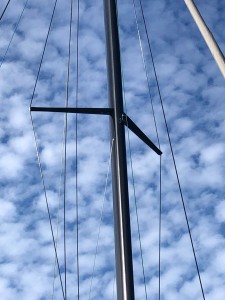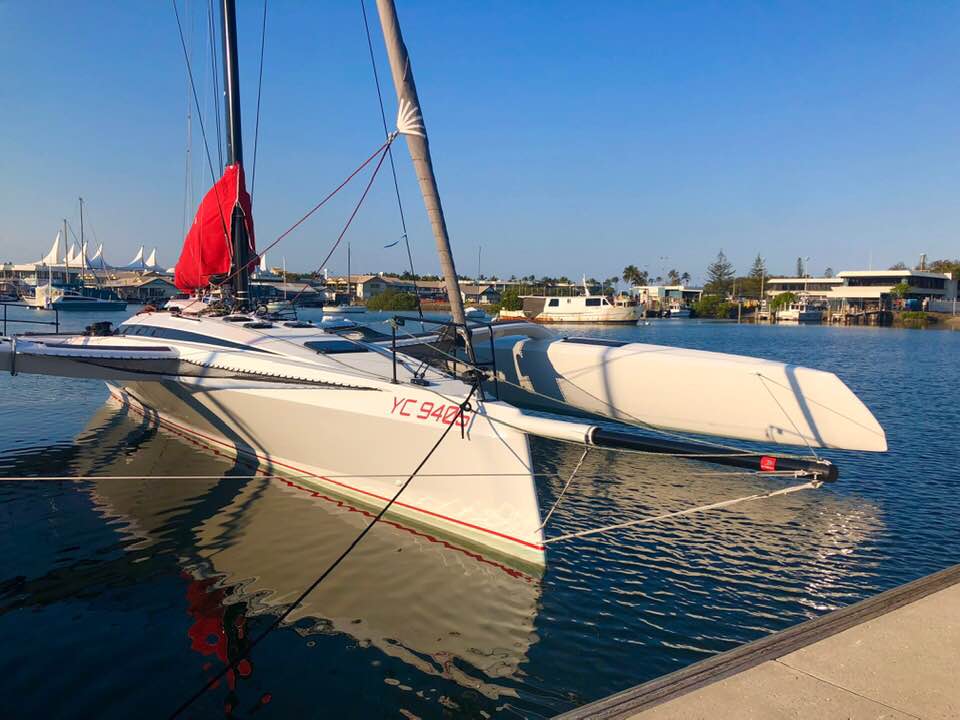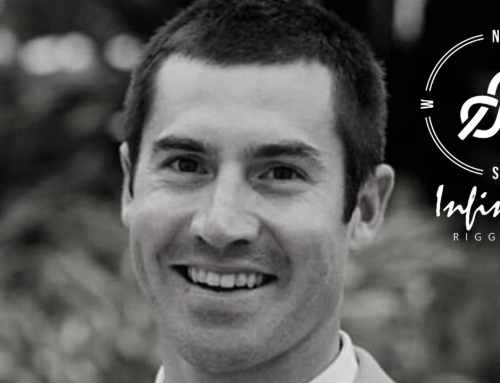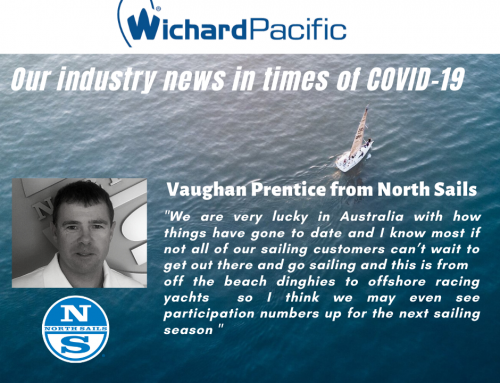Venom was built by ACMY on the Gold Coast earlier this year. This was in important project for us as it was a Group project. We supplied the carbon rig, the standing rigging and all furlers. Lorima designed a beautiful rotating wing mast and carbon fiber boom. Navtec France supplied the very sophisticated PBO standing rigging, Profurl the 8T structural furler and 5.0 Code 0 furlers, and Facnor the 5T internal lock. Plus of course a mix of various Wichard & Tye Tec deck fittings. We had the chance to talk to all 3 parties involved in the built…
Can you explain to us how the project was born, and what the original brief was?
B.K. Jamie first brought Bob to us, but I had sailed with Bob onboard the Grainger 32 “Carbon Credits” and was aware of his interest in building a 40ft + trimaran.
J.M The client came to me wanting a line honours ocean-going trimaran. Him knowing my history of Multihull racing in Australia and specialising in building performance multihulls, the foundations were set.
J.B. We got involved in the process quite early on, before the build was commissioned…we were really only engaged to give some budgetary figures to the potential builder, once the build was confirmed we were engaged straightaway, with a project like this there needs to be an open line of communication between client/designer/builder/sailmaker and ourselves as the riggers to make sure the expectations of the client are met.The original brief from the rig point of view was to have a lightweight bulletproof mast, that would be user-friendly for shorthanded sailing as well as having all the bells and whistles for a racing boat as well….
How far did you push the original design from what we can see today?
B.K Apart from some main hull mods I am pretty sure the final design is very close to what Tony had on his drawing board (Jamie to confirm) apart from the rig height going up! We did discuss lifting foils and the beams and structure were engineered for these so they can be added at a later date if required.
J.M From the first set of drawings, we extended the rig, overall beam and a little tweak to the rocker aft
J.B The original design for the rigs was always quite open, therefore to a degree we had a clean sheet of paper to work with, there is some basic info given by the designers and then with numerous round tables we came up with the final result that all parties agreed on.
What were the biggest challenges you faced during the project? And how did you determine the final rigging package?
B.K. For me designing the Sails and also building them to a finished stage before the rig is even here presented a challenge and is not ideal. We have a few small things I would have done differently but we were ready to fit sails when the boat launched at Bob’s request so he could be sailing and get the boat to South Australia ASAP. I am glad we could help Bob achieve this goal although there is some extra stress involved from the sailmaker’s perspective.
J.M The region sales were discussed from day one and were the major part of the build.
J.B The whole process, once we were engaged, was fairly simple, doing this day in day out makes it fairly easy, to be honest, it was one of the simpler projects we have worked on, when you have a group of people shooting for a common goal and whose thought pattern is the same it makes the process a lot cleaner and simpler….

Lorima carbon mast. Wing mast
The rig is a rotating mast – how does it benefit the performance of the boat and which challenges does it create from a rigging perspective?
B.K A wing mast like Bobs has received is a beautiful thing to sail to windward with, it creates a highly efficient mainsail shape that is powerful but can also be used to depower the sail as the wind increases. The lack of rigging required makes for a low-drag set up that could also be easily modified to canting in the future.
J.M The rig is a simple single spreader wing mast which is light and stiff.
J.B There are many advantages to a rotating rig, the obvious one is the flow of the breeze onto the mainsail, cleaner air flow equates quite simply to a faster boat….
Being a powerful and light trimaran is there any system to help her prevent capsizing?
B.K The mainsail has three rows of reefs with the 3rd located above the 50% height and coupled with a Heavy Weather Jib on the inner forestay you can effectively depower the boat. The overall width and huge float volumes are giving a very stable platform that coupled with the light overall weight make for a very easily driven boat you can reef quite early without performance loss.
J.M In order to help prevent capsize, we used a simple 2-to-1 mainsheet and traveller sheet…
J.B As the crew learns the boat they will have to stay vigilant with reefing at the correct points in the wind range and this will give them a boat that will look after them and also be bloody fast.
Can you tell us how you calculated the loads to be expected, as this is not always easy to do with such a boat?
J.M Throughout the build we used the righting moment of the boat for rig deck gear etc
B.K. For the sails, we had the righting moment calculation provided by the Lorima Design Office, the rig engineering to be guided by and our knowledge from many previous projects with comparable loads. Due to the crossover nature of the boat requiring both shorthanded Cruising and fully crewed Racing capability, the sails are overbuilt from a racing perspective with reasonably high safety margins in our engineering.
J.B. We don’t really get involved in the calculation of loads on a project like this, no matter how these projects are handled there is generally always a third party involved to run the numbers… The biggest thing with rigs like this is they generally have limitations put on them by the designers, because the boat is so powerful there needs to be limitations put on the sail configurations in different conditions. There is no doubt that you could build a rig that you would never have to reef but the offset to that is huge weight and with huge weight comes huge costs and of course, weight does not = performance so there needs to be calculations done on how to use the rig and sail package to get the best of both worlds, this is something we were fairly heavily involved in trying to hit the sweet spot for both tube builder and client…
Please describe the stays used on the boat. How much difference do you think the Navtec PBO rigging will make in performance or reliability?
B.K. I was very impressed with the rig as a whole, the section is really stiff and will give the boat the ability to achieve its full potential. The Navtec PBO rigging is a very light and low drag for fibre option, the lashing end fittings are very neat and allow for easy adjustment of the lower lashing points and soft attachments loops at the top ends.
J.B. We have gone for PBO diamond stays on the boat and Aramid side stays and forestay. The blend is simply to get the best product for each purpose at a cost that isn’t inhibitive and of course, the weight savings over the wire are huge.
What are the plans for the boat? Racing? Ocean crossing? And how many crew are required?
B.K. I think the boat is going to do the King of The Gulf Regatta in SA in February which is the next Multihull Nationals and then the Adelaide to Lincoln race. After that, we all hope Venom gets back up to the East Coast to do the Gladstone and northern regattas.








